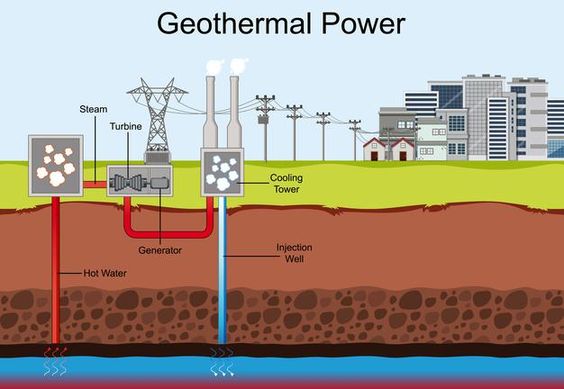A Closer Look at Energy Raw Materials: Exploring their Environmental Impact and Sustainable Alternatives
The future of energy raw materials: In our ever-evolving world, the demand for energy continues to rise. And with it, the exploration and extraction of raw materials to meet this demand. However, as we strive for progress. It is crucial to assess the environmental impact of these energy raw materials and seek out sustainable alternatives. In this article, we will take a closer look at the environmental consequences associated with conventional energy sources such as fossil fuels and nuclear power, and delve into the potential solutions that lie in renewable energy sources like solar, wind, and hydroelectric power. By understanding the environmental implications of our energy choices. We can make informed decisions that not only address the pressing issue of climate change but also contribute to building a more sustainable future.
Environmental impact of traditional energy raw materials
Traditional energy sources like fossil fuels and nuclear power have long been the backbone of our energy infrastructure. However, their extraction, production, and use come at a significant cost to the environment. Fossil fuels, such as coal, oil, and natural gas, release large amounts of greenhouse gases when burned, contributing to climate change. Additionally, the extraction of these resources often involves destructive practices like mountaintop removal mining and offshore drilling, leading to habitat destruction and water pollution. On the other hand, nuclear power, while not emitting greenhouse gases during operation, poses risks associated with radioactive waste disposal and the potential for catastrophic accidents like Chernobyl and Fukushima.
Sustainable alternatives to traditional energy raw materials
To mitigate the environmental impact of traditional energy sources. We must explore sustainable alternatives that can power our world without harming the planet. Renewable energy sources offer a promising solution. Solar power, for example, harnesses the energy from the sun through photovoltaic cells or concentrated solar power systems.
Wind power is another renewable energy source that has gained significant momentum in recent years. ind turbines convert the kinetic energy from the wind into electricity, providing a clean and abundant source of power. Wind farms can be established both onshore and offshore, taking advantage of the strong and consistent winds in coastal areas. While wind power does have some visual and noise impact, careful planning and technological advancements have minimized these concerns, making it an attractive option for sustainable energy production.

Hydroelectric power, generated by harnessing the energy of flowing or falling water, is one of the oldest and most widely used renewable energy sources. Large-scale hydroelectric dams can produce substantial amounts of electricity, while smaller-scale installations can power remote communities. However, the construction of large dams can have significant environmental consequences, including the displacement of communities, alteration of river ecosystems, and the release of greenhouse gases from the decomposition of submerged vegetation. Therefore, careful consideration must be given to the environmental and social impacts before implementing hydroelectric projects.

Geothermal power taps into the Earth's natural heat, utilizing the energy stored in the Earth's crust. This renewable energy source can be harnessed through geothermal power plants or ground-source heat pumps for heating and cooling purposes. Geothermal power is a reliable and steady source of energy, with minimal emissions and a small environmental footprint. However, its potential is limited to areas with accessible geothermal resources, such as volcanic regions or areas with hot springs.

Sustainable fuel alternatives: biofuels
In addition to renewable electricity generation, sustainable fuel alternatives play a crucial role in reducing greenhouse gas emissions and transitioning to a low-carbon economy. Biofuels, derived from organic matter such as crops, agricultural residues, and algae, offer a renewable and cleaner substitute for traditional fuels. Ethanol, for example, can be produced from corn, sugarcane, or cellulosic biomass, and can be blended with gasoline to reduce the carbon intensity of transportation fuels. Biodiesel, made from vegetable oils or animal fats, can be used in diesel engines. Reducing emissions of particulate matter and sulfur compounds.
However, the production of biofuels is not without its challenges. Large-scale monoculture crops for biofuel production can lead to deforestation and habitat destruction. And the intensive use of water and fertilizers can contribute to environmental degradation. Additionally, the displacement of food crops for biofuel production can have negative impacts on food security and prices. Therefore, sustainable biofuel production must prioritize the use of non-food feedstocks, promote responsible land use practices, and ensure that the overall lifecycle emissions of biofuels are lower than those of fossil fuels.
Sustainable fuel alternatives: hydrogen fuel cells
Hydrogen fuel cells offer another sustainable fuel alternative with the potential to revolutionize various sectors, including transportation and power generation. Fuel cells convert hydrogen and oxygen into electricity, with water as the only byproduct. Hydrogen can be produced from renewable sources such as water electrolysis. Utilizing surplus renewable energy to generate hydrogen for later use. The use of hydrogen fuel cells can significantly reduce greenhouse gas emissions, improve air quality, and enhance energy security.
While hydrogen fuel cells hold great promise, there are still challenges to overcome. The production of hydrogen requires energy, and if not sourced from renewable sources. It can still contribute to greenhouse gas emissions. Additionally, the infrastructure for hydrogen production, storage, and distribution needs further development to support widespread adoption. However, ongoing research and technological advancements are steadily addressing these challenges, bringing us closer to a future powered by hydrogen.
The future of energy raw materials: advancements and innovations
As we progress towards a sustainable energy future, advancements and innovations in energy raw materials are crucial. Research and development efforts are focused on improving the efficiency and cost-effectiveness of renewable energy technologies. As well as exploring new materials and methods for energy storage. Battery technology, for example, is rapidly evolving, with the development of more efficient and affordable lithium-ion batteries, as well as the exploration of alternative materials like solid-state batteries and flow batteries. Energy storage solutions are vital for stabilizing the intermittent nature of renewable energy sources and ensuring a reliable and resilient energy grid.
Furthermore, emerging technologies such as artificial photosynthesis and advanced nuclear reactors hold great potential for sustainable energy generation. Artificial photosynthesis aims to mimic the natural process of photosynthesis, using sunlight to convert carbon dioxide into fuels and other valuable chemicals. Advanced nuclear reactors, such as those utilizing thorium or molten salt. Offer safer and more efficient alternatives to traditional nuclear power plants. These advancements and innovations pave the way for a diverse and sustainable energy mix. Reducing our reliance on environmentally harmful energy sources.
Conclusion: transitioning to a sustainable energy future
In conclusion, the environmental impact of energy raw materials cannot be ignored as we strive for a sustainable and greener future. Traditional energy sources like fossil fuels and nuclear power pose significant risks to our environment and contribute to climate change. However, there are viable alternatives available. Renewable energy sources, such as solar power, wind power, hydroelectric power, and geothermal power, offer clean and abundant sources of energy. Sustainable fuel alternatives, including biofuels and hydrogen fuel cells, provide cleaner options for transportation and power generation. Advancements and innovations in energy raw materials and storage technologies further enhance our ability to transition to a sustainable energy future.
By understanding the environmental consequences associated with our energy choices and embracing sustainable alternatives. We can address the urgent issue of climate change, reduce pollution, and build a more resilient and sustainable energy landscape. The journey towards a sustainable energy future requires collective action, investment in research and development, and policy support. Let us strive towards a world powered by clean, renewable, and environmentally friendly energy sources. Paving the way for a brighter and greener future for generations to come.
